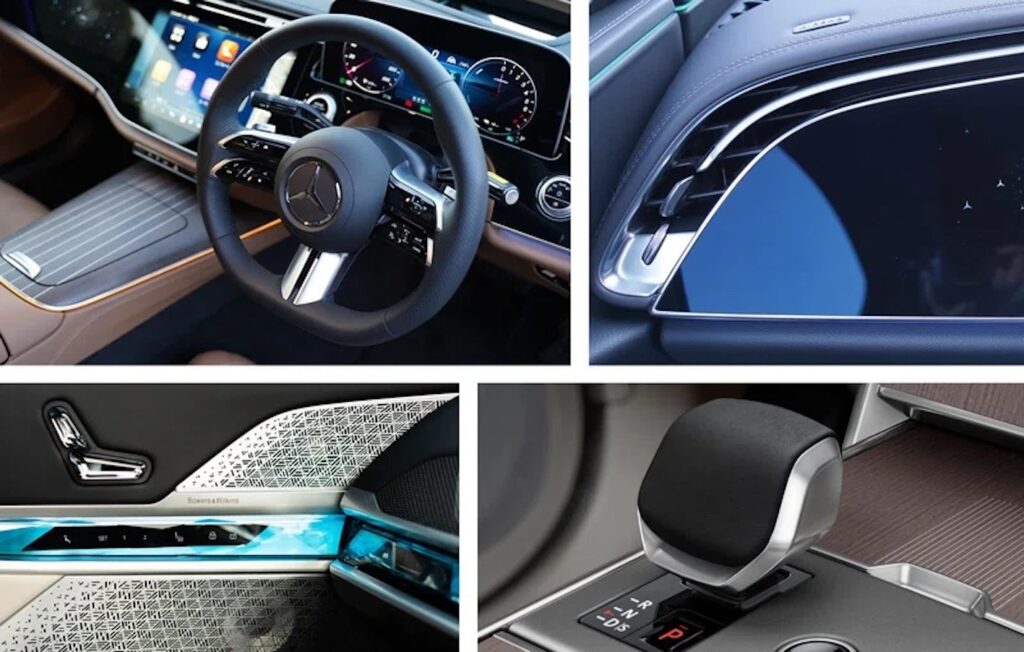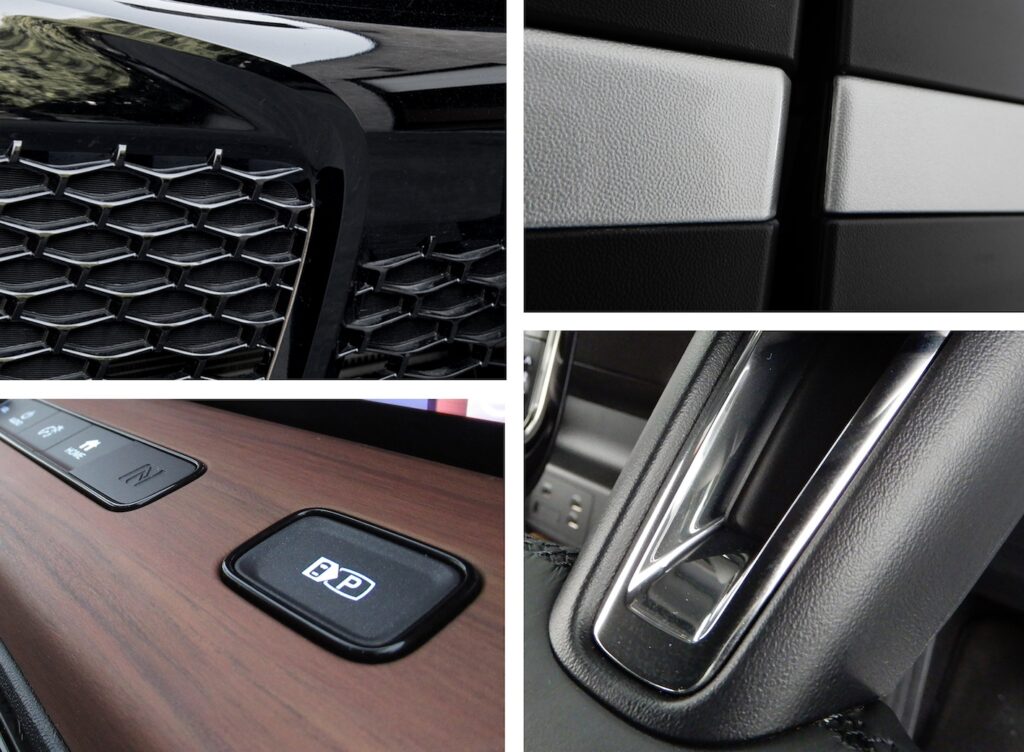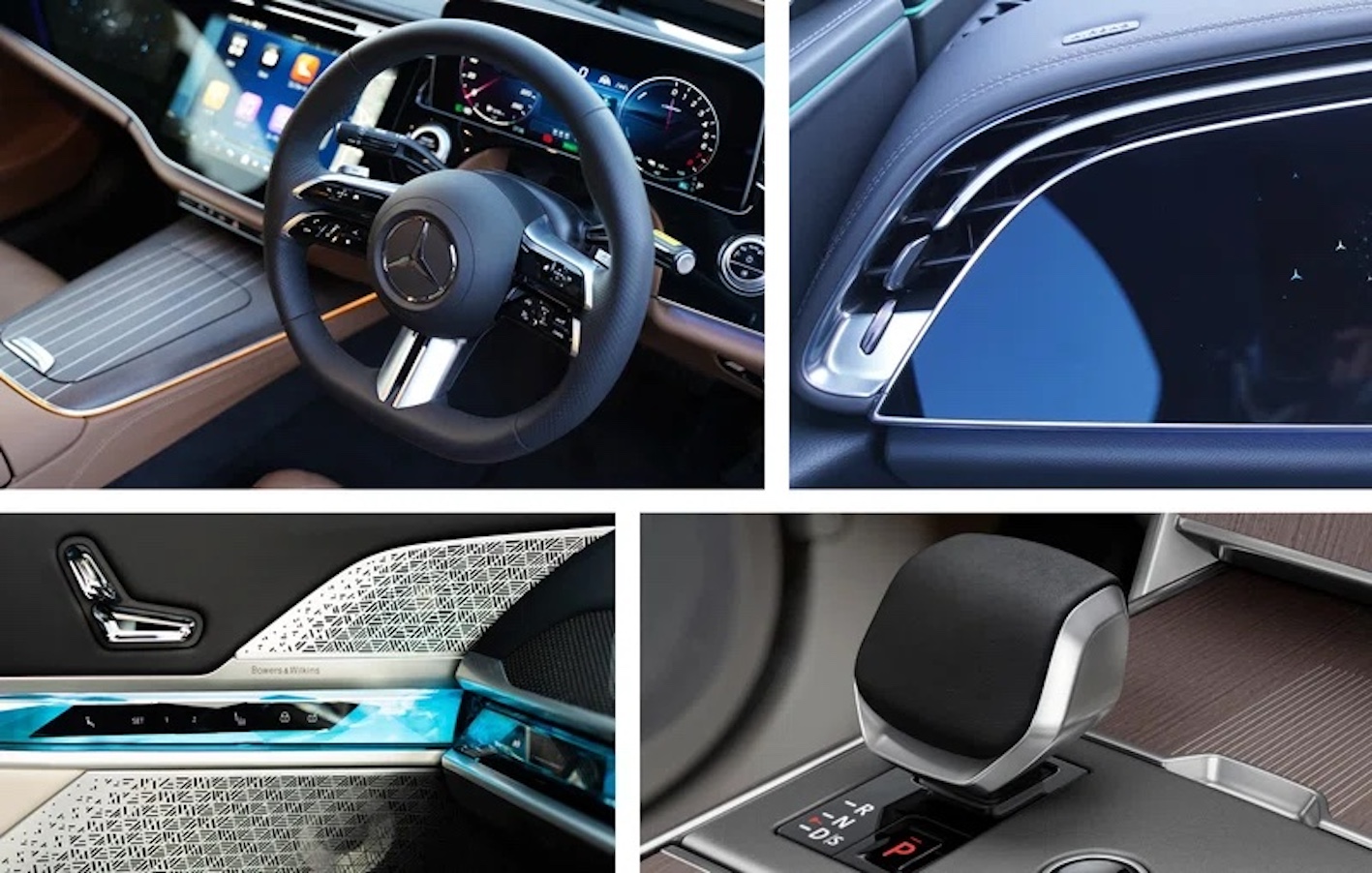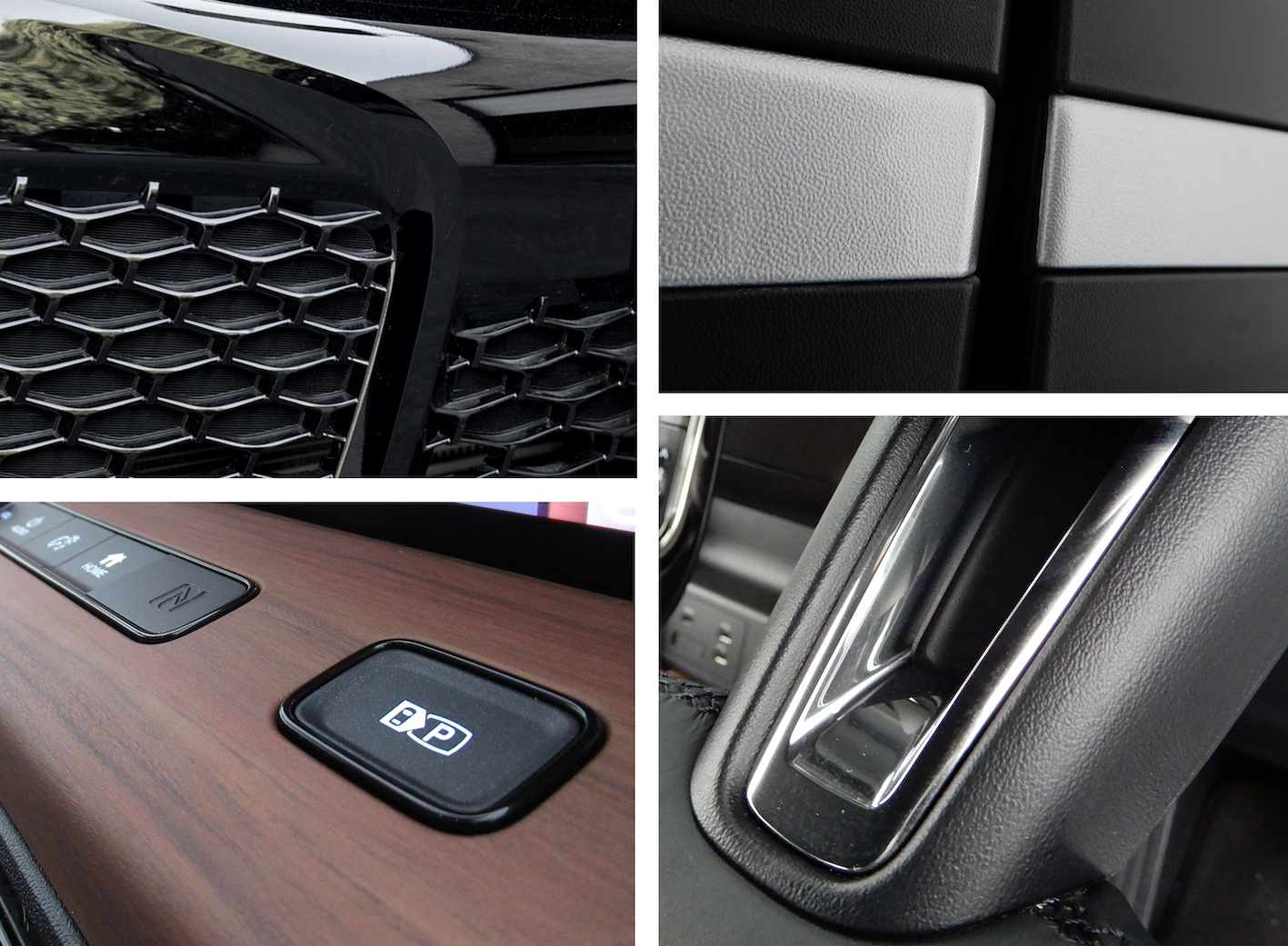感性と文化的背景
デザインの完成度をはかる指標のひとつである感性品質ですが、実はその本意は文化に根ざしているところがあるように感じています。
いうまでもなく自動車の歴史を紐解けばヨーロッパがその起点となりますが、長きに渡る欧州文化の変遷の中で育まれたクルマに対する美意識は、プレミアムブランドを筆頭として明確にそれらが形作られているのを見ることができます。特に質感においては古来それが皮革素材や本物の金属を用いられてきたことから、現在においても上質表現のイニシャルとしてリアル素材が随所に存在しているのは周知の事実です。
また、昨今の環境意識の高まりによるエコマテリアルやアニマルフリー素材への反応が早い点でも、素材と質感に対する感度の高さが伺えます。

欧州プレミアムブランドの内装を例とした素材とその表現の好例
上段:コンソールの本杢と極細ストライプのあしらい/厚みのあるレザー素材の質感の高いアクセントとなるシャープな金属加飾
下段:精緻で芸術的なアルミパンチングパターンのスピーカーメッシュ/アニマルフリー素材を使用したシフトノブ
一方日本は、工業発展の過程で培った高度な製造技術と共に安定的な大量生産という点において常にグローバルをリードしています。特に平滑な面を凹凸なくかつ極薄に成形したり、複雑な金型構造により抜き勾配*の難易度をかわす芸術的なものづくりから成る量産品質は、日本のブランド力を示す代表的なものです。
品質に対する考え方でも、この良し悪しのレベル(基本品質*)に対する尺度が非常にシビアで、感性品質の根幹を成すこの基本品質部分の“重み”は世界随一といっても過言ではないと思います。
*抜き勾配=射出成形において成形品を型から取り出しやすくするために金型につける勾配のこと。
*基本品質=隙間や段差、凹凸や歪みのない部品精度のこと.
例として、樹脂製品の中でも射出成形(インジェクションともいう)はクルマの多くの部分に使われている製法ですが、高熱溶解した液状の樹脂材を閉じた金型に開けたピンホール状の穴から高圧で射出して作る際、穴から金型奥の方まで到達する時間差によってウエルドと呼ばれる筋のような縞模様が表面に現れてしまうことが多くあります。
これは安価な日用品などのプラスチック製品ではよく見られる現象ですが、自動車では売価に相当すればあってはならない品質問題。これをあらゆる工夫でゼロレベルまで消し去り、かつ安定的に量産化できるノウハウは、特に部品製造を担う国内サプライヤー企業の多くがその大元を担っています。

上段左から:塗装レスピアノブラック/高定着性シルバー塗装/
下段左から:マット調木目調パネル/高輝度サテンシルバー樹脂メッキ
感性品質と基本的品質
今までの投稿でも幾度か触れましたが、感性品質の根幹には基本的品質が完成されていなければなりません。そこが不十分だと感性に訴えかけるデザイン表現が正確に形成されず、デザインが伝えたいメッセージが減衰してしまうからです。

基本品質の完成度はそのまま感性品質に影響する。(右側は基本品質が未完成)
日本の基本品質レベルは世界的に見てもかなり高いレベルであることはすでにグローバル的に認知されているのは言うまでもありませんが、
感性品質的にみると欧州勢はプレミアブランドを筆頭とした基本品質のレベルの高さを大前提とした上で、上質なマテリアルの使い方やその魅力を最大限活かすような造形表現に高い美意識を注力しているように感じます。
一方で、日本は基本品質の底堅さがカタチに宿り、あるべきカットライン、あるべき建て付けに忠実な正しさと共に、樹脂部品での表面処理や原材料着色(例えば無塗装のピアノブラック成形)など比較的ローコストで上質性を表現する手法の豊富さとその完成度は特筆すべき点であり、つまりは技術力の集約形そのものであるように思えます。
しかし製品デザインとしてみると、その上にレイヤーとして存在すべき「感じさせる」造形や加飾のあしらい、たたずまいに少し物足りなさを感じてしまう事があります。
特に気付くことが多いのは「〜風加飾」と呼ばれるいわゆるフェイクの表面処理がなされる部位です。
中型クラス車の内装などによく見られるシルバーに塗装された金属風加飾パネルは、本来シルバー色とする意味を考えると「金属のようにシャープで硬質な形」であるべきと思うなか、比較的角アールが大きめの”優しいかたち”に見える車種を幾つか見てきました。開発者達にデザイン意図を聞いた事もありますが「成形条件を考えるとこれが限界」「衝突要件がクリアできなくて」という苦労話が出てきます。これは立ち返れば日本の誇る基本品質の高さが、ある意味で感性品質の達成レベルのマイナス要因になっているとも考えられないでしょうか?
感性やテクニックにおいてグローバル比較でも決して劣ることはない日本のデザイナーの力が存分に現れるべきプロダクトの姿が、それを開発する過程の中、特有の文化的背景によって何か変化しているものがあるのではないか。そう思えてなりません。
開発現場で日夜行われる具現化に向けた折衝や話し合いは「いいものを作ろう」というモチベーションが確実に存在している筈ですが、そのウエイトがどこかで「守り」の姿勢になってはいないでしょうか。
最終的なプロダクトの姿として「感じさせるデザイン」になっているかどうか、そういった意識は開発に関わる全ての分野の人々に共有されるべき概念ではないかと私は思います。
今回の事例は感性品質の”重心”的なものが文化的背景によって違いがある、という個人的なひとつの仮説ではありますが、グローバルに舞台を持つ日本のメーカーで”PQ指標*”を考える時にも、作り出す造形の持たせる意味とその理にかなうカタチ、それに相応しい質感、といった全てが満たされたゴールを目指し、その具現化のために持ち前の高い基本品質技術が連動すればもう怖いものはなく、日本は感性品質として最強のプレイヤーになれる筈です。
その一助として微力ながらこのような形での投げかけを今後も続けていければと思っています。
Perceived quality and Cultural Interpretation [ Perceived Quality Series Vol.4 ]
Sensitivity and Cultural Background
Perceived quality is one of the indicators of design perfection, but I feel that its true meaning is actually rooted in culture.
Needless to say, the history of the automobile can be traced back to Europe, and the aesthetic sense toward cars that has been nurtured through the long transition of European culture can be seen clearly taking shape in the premium brands at the top. It is a well-known fact that realistic materials exist everywhere as initials of high-quality expression even today, especially in terms of texture, since leather materials and real metals have been used since ancient times.
European cars are also highly sensitive to materials and textures, as evidenced by their quick response to eco-materials and animal-free materials in response to the recent rise in environmental awareness.

Upper row: Genuine wood and ultra-fine stripes on the console/ Sharp metal decorations that accentuate the high quality of thick leather materials.
Lower row: Speaker mesh with an exquisite and artistic aluminum perforated pattern / Shift knob made of animal-free material.
Japan, on the other hand, has always been a global leader in terms of stable mass production along with advanced manufacturing technology cultivated through industrial development. Especially, forming smooth surfaces with no unevenness and ultra-thinness. The quality of mass production, which consists of artistic manufacturing that dodges the difficulty of draft angle* through complex mold structures, is representative of the power of the Japanese brand.
In terms of quality, the level of goodness or badness (basic quality*) is very strictly measured, and it is no exaggeration to say that the “weight” of this basic quality part, which forms the basis of Perceived quality, is the highest in the world.
*draft angle= A slope on the mold that facilitates removal of the molded product from the mold during injection molding.
*basic quality= The accuracy of parts without gaps, bumps, unevenness or distortion.
For example, injection molding is a process used for many parts of cars. When the resin material, which has been melted at high heat to a liquid state, is injected at high pressure through pinhole-shaped holes in a closed mold, the heat of the resin varies due to the difference in the time it takes for the resin to reach the back of the mold from the hole often results in a streak-like stripe pattern called “weld” appearing on the surface.
This is a common phenomenon in plastic products such as inexpensive daily necessities, but it is a quality problem that should not exist in expensive automobiles.
The know-how to eliminate this problem to the zero level by all kinds of ingenuity and to stably mass produce these products is the advanced technology of Japanese domestic supplier companies that are responsible for parts manufacturing, and many of these suppliers are responsible for high quality.

Top row, from left : Piano black without paint / High-fixation silver paint
Bottom row, from left : Matte wood-grain panel / High-brightness satin silver resin plating.
Perceived Quality and Basic Quality
As we have mentioned several times in previous articles in this series, basic quality must be completed at the core of perceived quality. If this is not sufficient, the design expression that appeals to the senses will not be accurately formed, and the message to be conveyed by the design will be attenuated.

The level of completion of Basic Quality directly affects Perceived Quality. (Basic quality is not completed on the right)
Needless to say, it is already globally recognized that the level of basic quality in Japan is quite high even when viewed from a global perspective,
In terms of perceived quality, European brands, led by the premier brands, seem to be focusing their aesthetic sense on the use of high-quality materials and formative expressions that maximize their appeal, based on the premise that the level of basic quality is high.
On the other hand, Japan’s solidity of basic quality is reflected in its shapes, and the abundance and perfection of methods to express high quality at relatively low cost, such as surface treatment of resin parts and coloring of raw materials (for example, piano black molding without painting), as well as correctness in adherence to ideal cut lines and construction, are also worthy of special mention, In other words, it seems to me that this product is the culmination of technological strength itself.
owever, as a product design, I feel that it is a little lacking in the “feeling” modeling, decoration, and appearance that should exist as layers on top of the product design.
Particularly noticeable are the areas where so-called fake surface treatments called “〜style decorations“ are applied.
The silver-colored metal-like decorative panels often seen in the interiors of mid-size class cars should be “sharp and hard like metal,” considering the original meaning of the silver color. However, we have seen several models with relatively large corner curves that look like “gentle shapes”. I have asked the developers about their design intentions, and they have told me stories of hardship, such as, “This is the limit considering the molding conditions,” and “We couldn’t meet the collision safety requirements. In this light, is it possible that the high level of basic quality that Japan prides itself on is a negative factor in the achievement of perceived quality?
In the process of developing such products, the unique cultural background of Japan may have changed the form of products that should fully display the capabilities of Japanese designers, whose sensibilities and techniques are not inferior to those of global comparisons. I cannot help but think so.
The negotiations and discussions that take place day and night at the development site toward the realization of a product must surely be motivated by the desire to “create a good product,” but is the weight of this motivation somewhere in a “defensive” posture?
I believe that the concept of “design that makes you feel” as the final product should be shared by people in all fields involved in development.
This case is my personal hypothesis that there may be differences in the “center of gravity” of perceived quality depending on cultural backgrounds,
When Japanese manufacturers in the global market think of “PQ index*,” when they aim for a goal that satisfies all of the following criteria: the meaning of the modeling they create, a shape that makes sense, and a texture that is appropriate for it, there is nothing to fear anymore if the high basic quality technology they have is combined to realize the goal. Japan can become the strongest player in the field of sensory quality.
I hope to continue to offer my opinions as a small contribution to this effort.

![by Car Styling [カースタイリング]](https://motor-fan.jp/wp-content/uploads/2025/04/carstyling-jp_logo.png)








